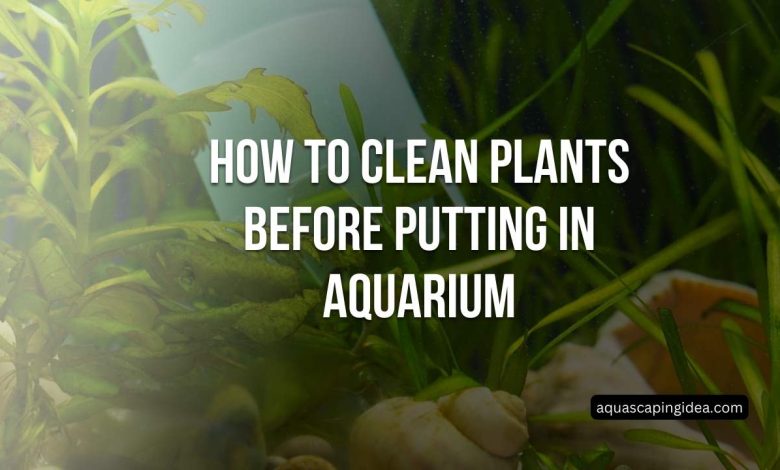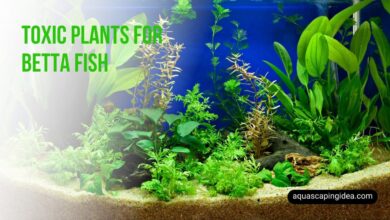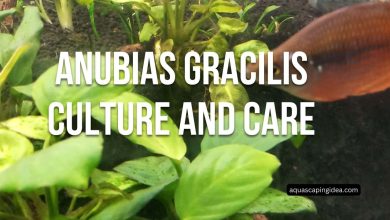How To Clean Plants Before Putting In Aquarium?

Diamond Tetra It is naturally found in the waters of South America making these the new best option. Tank Setup Keeping your dosage to within the recommended levels will keep your aquarium healthy and your algae under control. This is a risky proposition as your aquarium is essentially a delicate balance of plants, algae, pests and potential pathogens, and adding new plants without proper cleaning may disturb this balance. In this extensive how-to, we will demonstrate the most crucial steps you need to clean your tank plants well for a seamless transition as well as a successful and healthy environment in your aquascape.
Importance of Cleaning Aquarium Plants:
Before delving into the cleaning process, it’s crucial to understand the significance of properly cleaning aquarium plants. Neglecting this crucial step can have severe consequences, such as:
Pest Infestation:
Aquarium plants can harbor various pests, including snails, hydras, and even tiny crustaceans. These hitchhikers can quickly multiply and disrupt the balance of your aquarium, leading to potential problems for your fish and other inhabitants.
Algae Bloom:
Uncleaned plants may introduce algae spores or excess nutrients, triggering unsightly and potentially harmful algae blooms within your aquarium.
Disease Transmission:
Some plants may carry pathogens or harmful bacteria, posing a risk to the health of your fish and other aquatic life.
Water Quality Degradation:
Decaying plant matter, debris, or excess nutrients can quickly degrade the water quality, resulting in ammonia spikes, low oxygen levels, and an overall inhospitable environment for your aquatic inhabitants.
By taking the time to properly clean your aquarium plants, you can mitigate these risks and ensure a healthy, thriving ecosystem for your underwater inhabitants.
Preparing for the Cleaning Process:
Before you begin the cleaning process, it’s essential to gather the necessary supplies and equipment. Here’s what you’ll need:
- A large, clean bucket or container
- Dechlorinated water or aquarium water
- A pair of scissors or pruning shears
- A soft-bristled brush or toothbrush
- Aquarium-safe disinfectant solution (optional)
- Tweezers or forceps (for removing stubborn debris or pests)
Step 1: Visual Inspection and Removal of Debris
Start by visually inspecting the plants for any obvious signs of pests, algae, or debris. Use your hands or a pair of tweezers to gently remove any visible pests, snails, or decaying plant matter. This initial step helps reduce the overall workload and prevents the potential spread of contaminants during the cleaning process.
Step 2: Plant Trimming
Once you’ve removed any visible debris, it’s time to trim the plants. Using a pair of clean scissors or pruning shears, carefully trim off any damaged, discolored, or excess growth. This not only improves the plant’s appearance but also helps remove potential hiding spots for pests and encourages new, healthy growth.
Step 3: Soaking and Agitation
Fill your clean bucket or container with dechlorinated water or aquarium water. Gently place the trimmed plants into the water and let them soak for at least 30 minutes to an hour. This soaking period helps dislodge any remaining debris, pests, or algae that may be clinging to the plants.
During the soaking process, periodically agitate the water by gently swirling the plants around or using your hands to create gentle currents. This agitation helps loosen any stubborn contaminants and encourages them to settle at the bottom of the container.
Step 4: Brushing and Rinsing
After soaking for some time, the plants were prepared for their cleansing. Using gentle strokes of a soft brush or clean toothbrush, tendrils, stalks and roots were scrubbed to remove any lingering debris, algae or unwelcome visitors adhering still. Thorough brushing helps make certain surfaces are spotless once more.
Upon completing the brushing, the plants were lifted with care from the water for a final rinse. Under a steady stream of dechlorinated water or that from the aquarium itself, stragglers were flushed away. This rinse ensures all loosened contaminants have been washed off and the flora is cleanly purified for introduction anew to their watery home.
Optional Step: Disinfection (Not Recommended for All Plants)
While disinfecting aquarium plants can offer extra precaution, care must be taken as some species are quite sensitive to certain chemicals. Before subjecting plants to any sterilization method, thoroughly research a plant’s individual tolerance for the disinfectant under consideration. Certain plants may react badly to even dilute bleach or hydrogen peroxide solutions that prove safe for others.
If disinfection is pursued, strictly adhere to manufacturer instructions for aquarium-approved products. Common choices are diluted bleach, potassium permanganate, or hydrogen peroxide, but these require careful handling. Soak flora in the sterilizing solution for the specified duration then rinse abundantly with dechlorinated water. Remove any vestiges of chemical residue which could later endanger inhabitants. With comprehension of each species’ proclivities and by following labels exactly, disinfecting can be accomplished prudently for added assurance against pathogens.
Step 5: Quarantine and Observation
While performing standard sanitization ended my preparatory stages, a temporary isolation for the flora nonetheless seems advisable to scrutinize for any holdout plagues or other indications of unease. This brief quarantining gives occasion to intently regard the subjects for several solar days prior to placement amongst their final aquatic acquaintances. Throughout this duration of remove, vigilantly surveillance the subjects for even the remotest signal of uninvited guests, algal blooms, or discolorations – lest corrective steps must be repeated or other cleansing strategies be regarded.
Step 6: Acclimation and Introduction to the Aquarium
If your plants have properly finished the quarantine without any troubles, it’s time to adapt them to the conditions of your main tank. Gradually introduce the plants to the water in a sealed bag that’s filled with aquarium water for around 30 minutes up to an hour. This method helps the plants change to the water parameters and temperature of your aquarium.
Once the adjusting time has finished, cautiously take the plants out of the bag and tenderly place them in their wanted spots within the tank. Avoid entombing the plants too deeply, as this can impede their growth and possibly cause problems.
Some plants may flourish more if their roots are partially exposed to the water, allowing for more nutrient absorption. While others thrive with their roots securely hidden in the substrate. It’s best to do some research on your specific types of plants to understand their individual needs and optimal growing conditions. Carefully moving plants is a delicate process, but with some precaution your new flora should settle in well to happily grow.
Ongoing Plant Maintenance
While clean stock has now settled into the aquarium environment, continued diligence remains key to sustainable flourishing. Periodic maintenance like water changes under the luminous glow ensure nourishing circulation for all inhabitants. Structured care at consistent intervals forestalls potential problems down the line.
Moreover, dedicated observation may reveal creeping invaders, encroaching scum or latent afflictions. Nip trifling troubles in the bud by quarantining the compromised or siphoning and refreshing portions of the volume. For puzzling peculiarities, seasoned aquarists and aquaculturists offer troubleshooting help through their accumulated practical wisdom.
Table: Cleaning Methods for Different Plant Types
| Plant Type | Recommended Cleaning Method | Notes |
|---|---|---|
| Stem Plants (e.g., Anacharis, Cabomba) | Soaking, brushing, and rinsing | Avoid disinfection unless necessary, as it can damage delicate stem plants. |
| Rosette Plants (e.g., Cryptocoryne, Echinodorus) | Soaking, brushing, and rinsing | Pay extra attention to cleaning the crown and rhizome area, where pests often hide. |
| Floating Plants (e.g., Duckweed, Frogbit) | Gentle agitation and rinsing | Avoid vigorous brushing or disinfection, as these plants are delicate. |
| Moss and Fern Species | Soaking, gentle brushing, and rinsing | Be careful not to damage the delicate fronds or leaves during cleaning. |
| Rhizome Plants (e.g., Anubias, Java Fern) | Soaking, gentle brushing, and rinsing | Avoid disinfection, as it can damage the rhizome and stunt growth. |
| Rooted Plants (e.g., Vallisneria, Sagittaria) | Soaking, brushing, and rinsing | Pay extra attention to cleaning the roots and removing any debris trapped within. |
FAQ (Frequently Asked Questions)
Is it necessary to clean aquarium plants before adding them to the tank?
Yes, it is highly recommended to clean aquarium plants before introducing them to your aquarium. This step helps remove potential pests, algae, and debris that could compromise the health and balance of your aquatic ecosystem.
Can I use tap water to clean my aquarium plants?
No, it is not advisable to use tap water for cleaning aquarium plants. Tap water often contains chlorine and other chemicals that can be harmful to aquatic life. Instead, use dechlorinated water or aged aquarium water for the cleaning process.
How often should I clean my aquarium plants?
There is no set schedule for cleaning aquarium plants, as it depends on various factors such as the plant species, tank conditions, and overall maintenance routine. However, it’s generally recommended to inspect your plants regularly (every few weeks or monthly) and clean them as needed, especially when introducing new plants or after observing any signs of pests, algae, or debris buildup.
Can I use bleach or other household cleaners to disinfect my aquarium plants?
It’s not recommended to use household cleaners or undiluted bleach for disinfecting aquarium plants. These products can be harmful and potentially toxic to your aquatic inhabitants. If disinfection is necessary, use aquarium-safe disinfectants like diluted bleach solutions, potassium permanganate, or hydrogen peroxide, and follow the manufacturer’s instructions carefully.
My aquarium plants are melting or disintegrating after cleaning. What could be the cause?
Plant melt or disintegration can occur due to various reasons, including stress from the cleaning process, sudden changes in water parameters, or damage to the plant’s delicate structures. Additionally, some plant species may be more sensitive to certain cleaning methods or disinfectants. If you notice this issue, try adjusting your cleaning approach, providing optimal conditions, and consider seeking advice from experienced aquarium enthusiasts or professionals.
Can I skip the quarantine step after cleaning my aquarium plants?
Though separating plant life for observation prior to placement within one’s aquarium habitat is non-compulsory, the recommended precaution proves quite prudent, especially for flora newly incorporated into such a system. Quarantining permits meticulous monitoring of the specimens for any lingering irritants, algal proliferation, or indicators of afflictions in advance of their relocation into one’s principal tank environment. Neglecting this step risks introducing undesired organisms or disease agents into an established aquatic community, potentially upsetting fragile balances among established lifeforms therein.
Conclusion
Properly cleaning aquarium plants before introducing them to your aquarium is a crucial step in maintaining a healthy and thriving underwater environment. By following the outlined steps in this guide, you can effectively remove potential pests, algae, and debris, minimizing the risk of introducing harmful organisms or pathogens into your aquatic ecosystem. Remember that each plant species may have specific requirements and sensitivities, so it is essential to research and adapt the cleaning process accordingly. Patience and attention to detail coupled with a commitment to ongoing maintenance are key to ensuring the long-term health and beauty of aquarium plants. Carefully examining each leaf and stem under running water can reveal hidden hitchhikers that threaten botanical balance if left untreated. Consider different cleaning techniques for delicate versus hearty specimens to protect fragile flora from damage while still removing stubborn residue.


